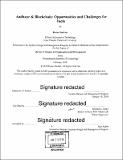| dc.contributor.advisor | Michael J. Casey. | en_US |
| dc.contributor.author | Sachan, Karan | en_US |
| dc.contributor.other | Massachusetts Institute of Technology. Integrated Design and Management Program. | en_US |
| dc.coverage.spatial | a-ii--- | en_US |
| dc.date.accessioned | 2018-10-15T20:23:41Z | |
| dc.date.available | 2018-10-15T20:23:41Z | |
| dc.date.copyright | 2018 | en_US |
| dc.date.issued | 2018 | en_US |
| dc.identifier.uri | http://hdl.handle.net/1721.1/118523 | |
| dc.description | Thesis: S.M. in Engineering and Management, Massachusetts Institute of Technology, System Design and Management Program, 2018. | en_US |
| dc.description | Cataloged from PDF version of thesis. | en_US |
| dc.description | Includes bibliographical references (pages 63-66). | en_US |
| dc.description.abstract | In India, the inability to prove one's identity is one of the biggest barriers that prevents the poor from accessing benefits and subsidies. India is a country with 1.3 billion residents in over 640,000 villages. The Indian government spends $50 billion on direct subsidies (food coupons for rice, cooking gas, etc.) every year. Both public and private agencies in India require proof of identity before providing services or benefits to those living in India. Until the introduction of the Aadhaar program, there was no verifiable identity number program that both residents and agencies could use. As a result, every time Indian residents tried to receive benefits, they had to undergo an arduous personal identification process. What made it even more difficult was that the various service providers had different document and information requirements. This made it especially hard for India's poor residents, who often lacked documentation and found it difficult to access services. The Unique Identification (Aadhaar) project was created in order to provide every resident of India with a unique identification number that can be used to access a variety of services and benefits. The project enables residents in India to receive food coupons, receive cooking gas deliveries, open checking accounts, apply for loans, insurance, pensions, property deeds, etc. In addition, the program makes it possible for the Indian government to make sure that welfare benefits go directly to the right person. Aadhaar is a centralized approach to provide identification and benefits to the citizens of India. It is plagued with some problems typical to a centralized system such as central authority, data privacy etc. In this thesis, we explore the Blockchain technology to improvise Aadhaar, a centralized paradigm to a de-centralized one. I have explored the ways in which the current welfare services could be evolved on the re-imagined Aadhaar system with Blockchain.. | en_US |
| dc.description.statementofresponsibility | by Karan Sachan. | en_US |
| dc.format.extent | 66 pages | en_US |
| dc.language.iso | eng | en_US |
| dc.publisher | Massachusetts Institute of Technology | en_US |
| dc.rights | MIT theses are protected by copyright. They may be viewed, downloaded, or printed from this source but further reproduction or distribution in any format is prohibited without written permission. | en_US |
| dc.rights.uri | http://dspace.mit.edu/handle/1721.1/7582 | en_US |
| dc.subject | Engineering and Management Program. | en_US |
| dc.subject | Integrated Design and Management Program. | en_US |
| dc.title | Aadhaar & Blockchain : opportunities and challenges for India | en_US |
| dc.title.alternative | Aadhaar and Blockchain : opportunities and challenges for India | en_US |
| dc.title.alternative | Opportunities and challenges for India | en_US |
| dc.type | Thesis | en_US |
| dc.description.degree | S.M. in Engineering and Management | en_US |
| dc.contributor.department | Massachusetts Institute of Technology. Engineering and Management Program | en_US |
| dc.contributor.department | Massachusetts Institute of Technology. Integrated Design and Management Program. | en_US |
| dc.identifier.oclc | 1054910734 | en_US |
